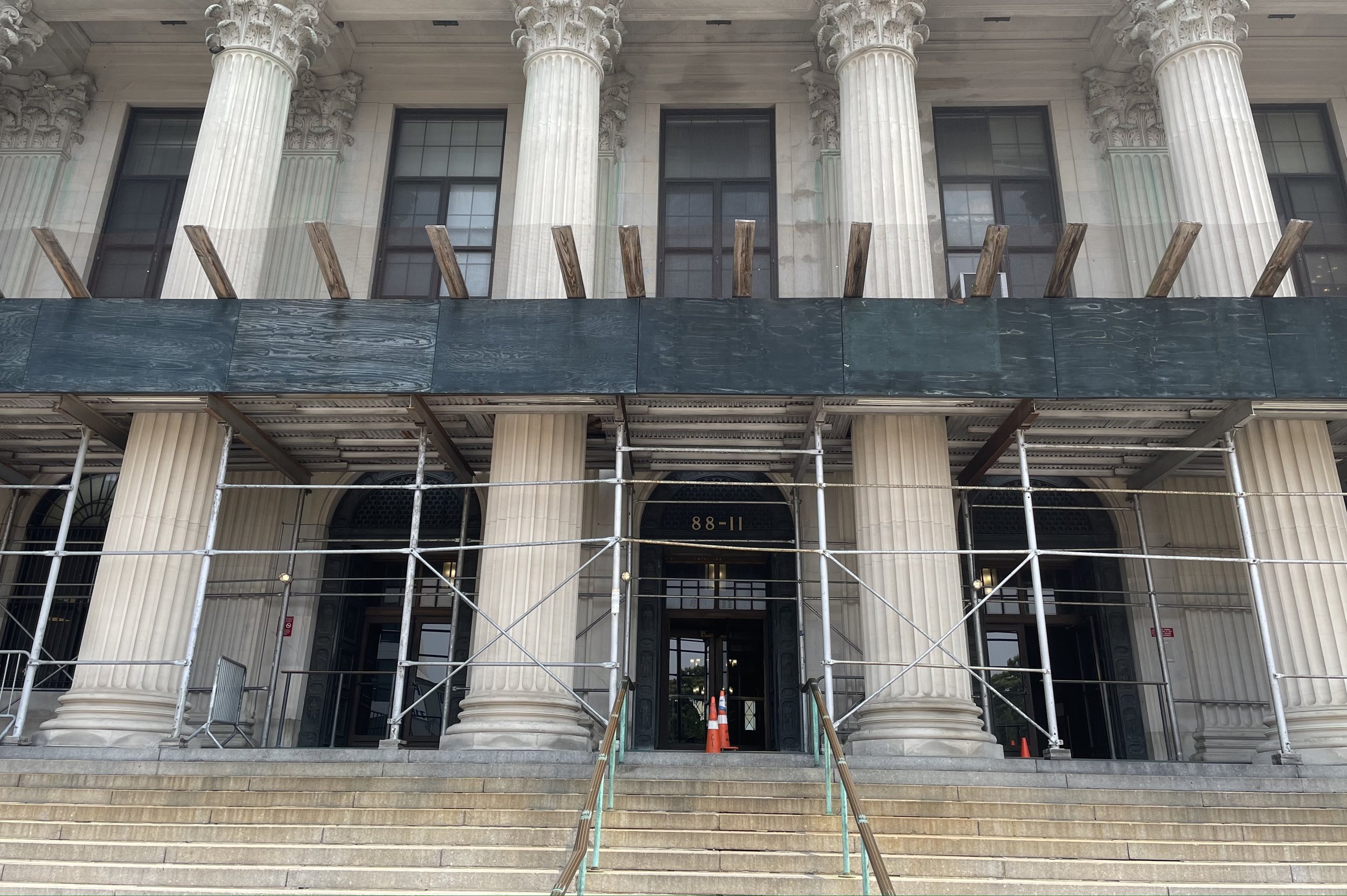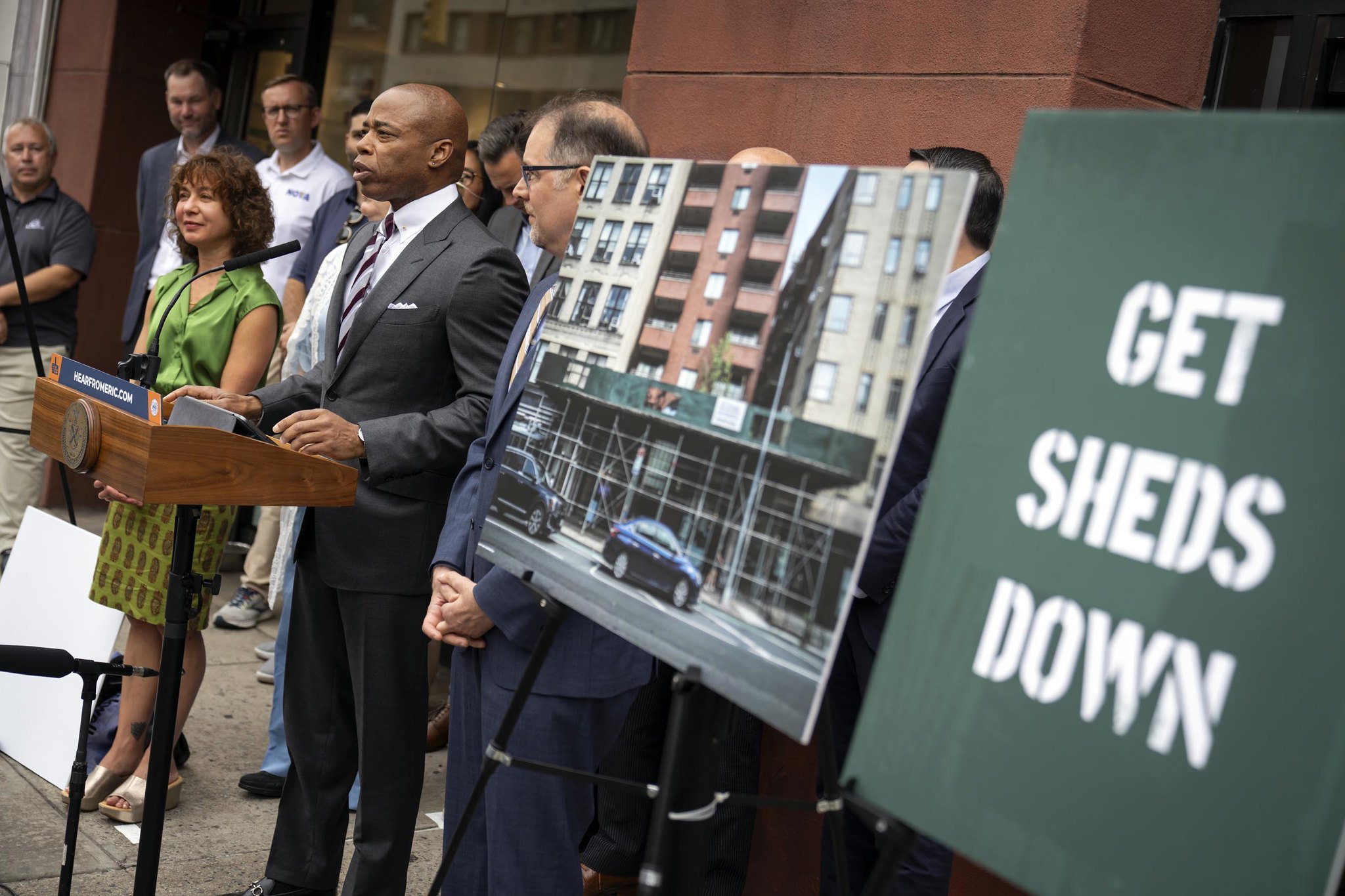Queens court’s scaffolding to be removed
/The scaffolding outside of Queens Supreme Court, Civil Term. Eagle file photo by Jacob Kaye
By Jacob Kaye
After over a dozen years, the scaffolding that wraps around the front of the Queens County Supreme Court building in Downtown Jamaica will soon come down. But the crumbling facade that necessitated the installation of the wooden shedding 14 years ago is still not expected to be fixed anytime soon.
Instead, the city will install netting around the front of the historic city-owned building on Sutphin Boulevard to protect court users, employees and judges from potential falling debris.
The courthouse will be the first city property in the five boroughs to have its sheds replaced with the safety netting, Mayor Eric Adams said.
The courthouse’s new protective coating was presented on Monday by the mayor as part of a plan to overhaul the city’s approach to scaffolding.
“Sidewalk sheds, also known as scaffolding, are the ugly green boxes that line our sidewalks,” Adams said on Monday. “They block the sunlight, keep pedestrians away from businesses and are a magnet for illegal activity.”
While the new rules and regulations surrounding scaffolding announced this week pertain mostly to private building owners, Adams said that the city also needs to lead by example.
“Look at the Supreme Court building in Queens County,” he said.
Beyond being an eyesore, the shedding at the neoclassical Queens courthouse has cost taxpayers nearly half a million dollars over the course of 14 years, and has frustrated judges and court staff who work at the courthouse located at 88-11 Sutphin Blvd., the Eagle reported last month.
Mayor Eric Adams announced on Monday that the scaffolding in front of Queens Supreme Court, Civil Term, will be replaced with safety netting. Photo by Ed Reed/Mayoral Photography Office
In June, a spokesperson for the Department of Citywide Administrative Services, the agency that manages the courthouse, told the Eagle that it had no immediate plans to remove the scaffolding, which had originally been built in anticipation of a facade repair project.
The scaffolding has become a semi-permanent fixture of the courthouse as the city has been unable to secure the $30 million needed to fix the front of the building.
In all, the agency has also spent $445,000 to maintain the shedding, which has been managed by several contractors over the years.
On Monday, the Eagle asked a City Hall spokesperson if the mayor’s plan to reform the city’s scaffolding practices included identifying funds to fix the front of the Queens courthouse. The spokesperson said that the funds had still yet to be secured.
Last month, Queens Supreme Court, Civil Term Judge Marguerite Grays told the Eagle that while she wasn’t “necessarily…frustrated” with the long-term scaffolding, she was “concerned.”
“I would like to see whatever movement we can make to either get the project completed or the scaffolding removed,” Grays said. “We want to make sure that it's safe for those who are passing on any side of the building. That’s the purpose of the scaffolding. I don't want any members of the public or members of this court family injured.”
“It’s a beautiful building, and, of course, we want the building maintained,” she added.
In a statement issued on Monday, DCAS Commissioner Dawn Pinnock said that the agency, which manages a majority of the city’s courthouses, “always prioritizes the safety of New Yorkers.”
“I am happy to support efforts to explore more appealing alternatives to the traditional sidewalk sheds that will maintain safety standards while improving the quality of life for New Yorkers,” Pinnock said.
In addition to the netting soon to be installed at the Queens courthouse, the city will require every city agency that owns a building that requires pedestrian protection to assess whether or not netting can be used.
According to the mayor’s office, while netting is already an option available to both private and public building owners, a lack of a uniform design that can be easily replicated prevents it from being used frequently.
To address the lack of standardization, the city will post a bulletin later this year, providing “clarity to design professionals and building owners around how netting can comply with standard [Department of Building] specifications and provide adequate public protection,” according to City Hall. Additionally, the DOB will work with professionals in the construction industry to better promote the use of netting, according to the mayor.
The scaffolding outside of Queens Supreme Court, Civil Term has been in place for 14 years as the city has been unable to come up with the funds to replace the building’s crumbling facade. Eagle file photo by Jacob Kaye
Adams also said that the DOB will issue a public request for proposals for sidewalk shed redesigns by the end of the summer. The mayor said that he was looking for proposals that included designs that were “less obtrusive, more visually appealing and still affordable for property owners to improve the pedestrian experience, while simultaneously offering critical overhead protection from any potential hazards.”
The winning designs will be selected by the end of 2024.
Adams also said that steeper fines would be issued to building owners located in several business districts when they fail to hit their construction timelines, increasing the length of time they’ll require scaffolding.
Property owners would be fined $10,000 when scaffolding is in place and the owner fails to hit their deadline to file a repair application; obtain required work permits; or fully complete repairs within 24 months.
Only building owners in either Midtown Manhattan, Downtown Brooklyn, Grand Concourse or Long Island City will be subjected to the increase in fines.
“This is how we reimagine our city and revitalize our business districts,” Adams said. “This is how we get people to spend money in New York City and make sure the beauty of our city shines through.”






